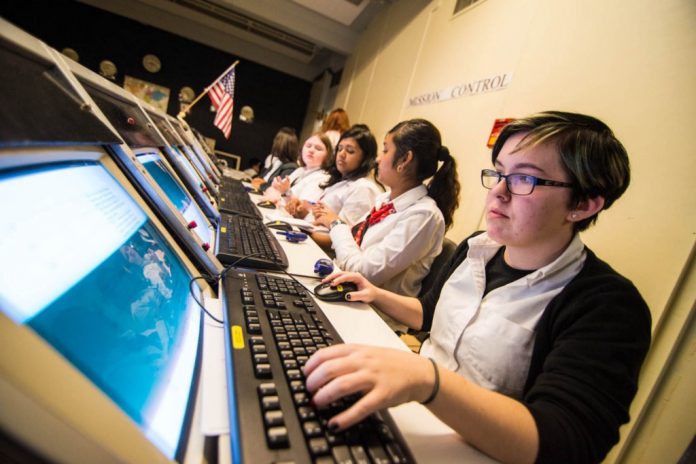Lauren Rooney, 16, at mission control during a SPARC emergency drill at Northeast High School, December 14, 2012, Philadelphia, Pa. (Maria Pouchnikova)
A fire has erupted in space.
Four astronauts had to think fast as alarms sounded and their shuttle filled with smoke. Just moments before, they had been smiling, talking and munching on snacks, enjoying the ride miles above the Earth.
They had been trained in how to handle an emergency, and they did.
Then the lights went out. Back on Earth, mission control’s screens went dark.
“We have no visual,” one of the flight’s managers said. “Is anyone hurt?”
“Everyone’s fine,” came the reply.
“How did the fire start?” mission control asked as the event unfolded last Friday morning.
The astronauts answered and went about their business of returning their mission to normal.
Astronauts had to attend to a fire emergency, mission spokeswoman Jessica Hattina told a crowd of students watching the mission from the Space Research Center inside the Medical, Engineering and Aerospace Magnet School.
Things go wrong during space missions, but the fire was something that was planned. Flight managers knew it was going to happen. Hattina, 17, quietly had flipped a switch that started “the fire” aboard the shuttle.
The emergency was part of a script written by Jeremy Cruz, 17, the mission’s flight director. Other managers knew it was going to occur and when. Shuttle pilot Briana Ferguson, 16; commander Jonathan Seitz, 16; mission specialist Peter Cruz-Parrilla, 14; and payload specialist Shawn Johnson, 15, weren’t in on that part of the minute-by-minute script, said Cruz.
Although mission managers knew what they were supposed to do and say, the astronauts had to rely on their training and improvise, Cruz said before Hattina threw the switch.
The shuttle jockeys handled it.
It wasn’t the first thing that had gone wrong that morning, director Margaret Karpinski said. There were other problems that weren’t in the script of the simulated mission to repair a NASA weather station.
“It’s been hectic,” Karpinski said Friday as ground control got ready for the ersatz emergency.
A large screen didn’t work; a camera didn’t either. All those woes did was force the students to think on their feet and make things right.
“They have to learn to take care of problems,” Karpinski said earlier last month.
The one-day mission was set as a trainer for SPARC’s two-day spring flight. The magnet school inside Northeast High has been sending kids on simulated space flights since the 1960s. The students go to Mars and they go to the moon.
“We are the only high school in the country that does this,” Karpinski said.
Early in Friday’s mission, student astronauts fixed a hole in a weather satellite. A video of their work played for other students all day.
Robotics managers Josh Carey and Brad Jacobson, both 17, demonstrated a remote-controlled robot moving items, and they gave other students chances to try their hands at guiding it.
Students participated in the mission in a variety of roles. Along with seniors Carey and Jacobson and 11th-graders Cruz and Hattina, junior Shareef Awarasneh, 16, works in administration and juniors Lawrence Delapena, 17, and Christian Lattanzio, 16, were in charge of computers. Samuel Barriskell, 16, and Tara Behr, 16, both juniors, were the engineering managers.
Built into Cruz’s script was an accident that kept medical managers junior Jenny Hoang, 16, and seniors Jessica Kirgin, 17 and Kayla Little, 17, busy. An astronaut got a simulated injury.
Along with Karpinski, SPARC project staffers were Joseph Connelly (engineering), Anne Johnson (medical) and Carole Niemiec (robotics).
Students need four years of both math and science to get the magnet school’s diploma, Karpinksi said, and they get to use their knowledge while participating in SPARC missions.
Math goes into robotics, for example.
“But we’re not talking upper-level math,” Karpinski said.
People need physics for space travel. The medical group learns how to keep medical logs and take blood pressure readings. They get Red Cross certifications and learn CPR, she added.
“We have a simulation software package,” Karpinski said. “The students learn to take off and land successfully.”
Many of the students who participated in last week’s mission are SPARC veterans. Graduate Ashleigh Niemiec, now a college student, returned to help out, too.
“A lot of these kids have done this now for two or three years,” Karpinski said in an interview two weeks before Friday’s flight.
But 20 students were new, Hattina said. Last week’s one-day mission “is good practice for the new kids,” Karpinski said.
Cruz has written other flight scripts, Karpinski said. Every single moment of the flight is scripted, Cruz added.
After a flight, there’s a post-mortem.
“We examine what happened, what can be done better, what went wrong,” Karpinski said. “We change things.”
The career benefits for the students?
“They develop leadership abilities,” Karpinksi said. “When they leave us, they are ready to assume leadership roles.” ••
Reporter John Loftus can be reached at 215–354–3110 or [email protected]





